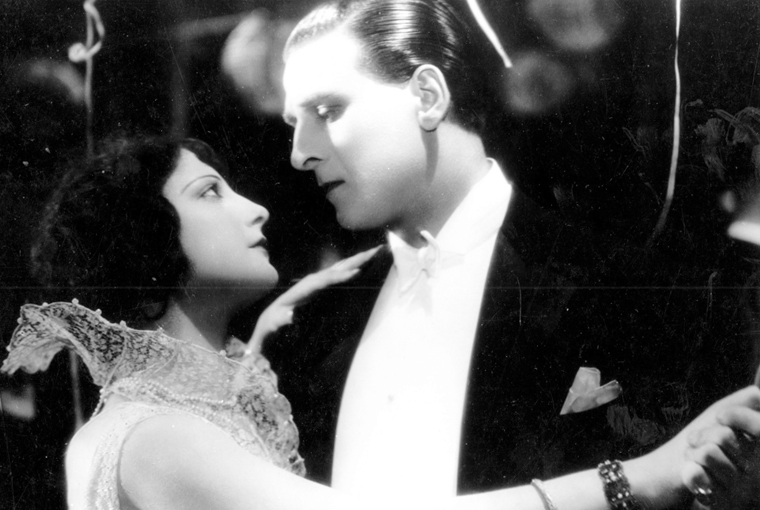The Destruction of Bliss
Gustav Machatý’s Erotikon (1929) and Ecstasy (Ekstase, 1933)
Vol. 78 (October 2017) by Colette de Castro
There is a widely cited, yet unfounded claim that the first female orgasm to be portrayed on film was the one simulated by the actress Maria Kiesler (later to become Hedy Lamarr) in Gustav Machatý’s 1933 film Ecstasy. Not only is this manifestly untrue – even Machatý’s preceding film Erotikon (1929) contains a similar orgasmic performance – , but a disproportionate number of articles about the film seem determined to mention this made-up fact.1
Like the kiss in Edison’s film (The Kiss, 1896), female orgasm has therefore been categorized as one of the great “firsts” in cinema, something to be observed and remarked upon – to be checked off in a neat little box for film historians. But unlike a kiss, it is not something that corresponds to a direct visual reality that portrays it. In fact, the female orgasm is often considered to be elusive. It thus blurs the line between an image of a phenomenon and the realm of pure “acting”. To quote Kapsalis quoting Barthes, “One cannot… represent bliss (as in orgasm) since bliss is the destruction of representation”2.
This categorization of a somewhat subjective portrayal of a real physical phenomenon seems to be another element of the so-called hegemonic male gaze – depicting the world from a masculine and heterosexual point of view, and thereby presenting women as objects of male pleasure. It reflects society’s need to frame, and thus control, female sexual pleasure. Of course the fact that this sex scene is portrayed by the 18-year-old Hedy, named “the most beautiful woman in Hollywood” probably made it all the more appealing to both male and female viewers.
Ecstasy is the story of an unhappily married young woman named Eva (Maria Kiesler), whose free spirit and boundless desires lead her to leave her much older husband for another man. Herein follows a description of the above mentioned scene, which occurs about halfway through Ecstasy: on a moonlit evening the female protagonist arrives at the home of a young engineer. With long determined strides, he quickly closes the space between them. The camera cuts from a close up of his whole face to an extreme close up of her pleading eyes, and then it pans down to her slowly parting lips. They kiss and he gently lowers her down onto a bed which has suddenly appeared. She keeps her eyes closed and her mouth open as he starts to make his way down her body, as she bites her curled finger suggestively. Now the camera is filming her face upside down – she lifts both her hands to clutch at her hair -, her elbows framing her alabaster-skinned face in a v-shape. Suddenly, and as the music climbs to a peak, her mouth contorts, her head jerks back and her elbows squeeze tightly together so that her face is hidden by her forearms.
The camera cuts to the wooden floor onto which her broken string of pearls has been flung next to a fur rug – and then back to her face. She lets her arms fall open to reveal a visage that is wreathed in bliss. Her head falls to the side and the camera cuts in rapid succession to her limp hand, the ceiling lamp, her bare knees, back to her open hand, then finally we see the man again, his head on her chest as she caresses his neck. A small smile appears on her face as she glances up at the camera, before she cozily closes her eyes once more. Pearls, lamp, then a box of matches and a hand sparking a match. The actress smokes a cigarette while lying on her back, a trail of smoke spiraling up toward the lamp. Thus ends the “orgasm scene” from Ecstasy.
At the time this scene itself was radical enough, not least because of the implications of oral sex, but Ecstasy also made headlines because of the scene in which Hedy Kiesler runs bare-chested through the forest to catch up with her horse. Such nudity caused a scandal, and though it was initially released in Czechslovakia and then in Austria, it had less success in the United States. The film was condemned by the Catholic Legion of Decency and was unable to get the Hays Code seal of approval. It was finally released on limited run in America without the seal, playing mostly independent art cinemas. Hedy Lamarr says in her autobiography that when she met Louis B Mayer of MGM in the United States he remarked about Ecstasy that “A woman’s ass is for her husband, not theatergoers”, warning her that “We make clean pictures”.
The instigator of all this scandal was one Gustav Machatý (1901–1963), a Czech film director, screenwriter and actor. Between 1929 and 1933 Machatý made a trio of Czech films all linked by the theme of sexual passion: Erotikon (1929), From Saturday to Sunday (1931) and Ecstasy (1933). Though the second film won’t be discussed here, all three films deal with the female quest for sexual fulfillment in one way or another, and they each represent female orgasm. Throughout most of the first half of the 20th century scientists believed that women could rarely experience orgasm, and that for the most part sexual bliss was purely a male realm. Dr. William Acton, the most prominent Victorian specialist in sexual and reproductive theory, reassured his contemporaries in a 1858 text that, “The majority of women (happily for them) are not much troubled with sexual feelings of any kind”, going on to describe any woman who experiences sexual pleasure as abnormal (as cited in Heroines of Popular Culture, 1987). A gynecological textbook published as late as in 1943 claims “The fundamental biologic factor in women is the urge of motherhood balanced by the fact that sexual pleasure is entirely secondary or even absent”. Similar examples are plentiful. Machatý, who wrote the script along with Frantisek Horky, was thus rather ahead of his time, in both form and content.
There is something refreshing in such a carefully thought-out and visually stunning representation of female orgasm. Though it is easy to dismiss the scene as quaint and unremarkable, it is quite rare to see filmmakers experimenting with visual portrayals of female sexuality. The trope of using noise to show what occurs most of the time in “an invisible place”3, has become yawningly predictable. A filmmaker once described to me a shoot involving a sex scene with two actors he didn’t yet know well: on the first take, and to the general astonishment of the film crew, the woman started groaning and screaming like one of Charcot’s hystériques. But who could really blame that actress? If sexual pleasure must be performed for the male gaze, then actresses have learned that making an oral spectacle of their pleasure is an essential part of this show. Before the use of sound in film was fully developed, filmmakers were obliged to be slightly more experimental in the portrayal of sexuality – which is exactly what we find here. Today, in a world in which the portrayal of female pleasure in sex relies heavily upon sound, it’s a relief to witness something that was made before this aural shortcut became commonplace.
The artistic ambition of Machatý’s films goes beyond sexual politics, however. His films experiment with techniques that complement the story and take it to new heights. As Ecstasy is still a silent film, he makes liberal use of facial expressions to externalize the character’s thoughts, often in the style of German expressionist filmmaker F. W Murnau (speaking of whom, I would argue that one of the first expressions of female orgasm was in Murnau’s 1922 film Nosferatu). Mirrors and unusual camera angles are often used by Machatý to show when something is going slightly wrong or is uncommon.
For the first half of Ecstasy the character of Eva looks at her new husband in disbelief, or looks at herself in the mirror sadly. Half of the orgasm scene from Ecstasy is made with the camera turned fully upside-down, at once as a reflection of Eva’s breathtaking experience and to reinforce the fact that the viewer is witnessing something unusual. This tilting technique is a favorite of Machatý’s. In fact you don’t have to go back very far in his filmography to find an example of another interesting tilt, on another beautiful woman’s face. This time it’s the face of Slovenian actress and beauty queen Ita Rina in Erotikon (1929).
The “orgasm scene” in this film is even more ingenious than that in Ecstasy. Here, we follow the story of Andrea (Ita Rina) who lives in a small house with her father. When a handsome stranger named George Sydney turns up late at night, she is quickly seduced – and the day after he arrives, he gains entry into her bedroom. There follows what could be argued to be the first Female Point of View sex shot, with the camera pointing straight up towards George, who lurches unromantically above her for a few seconds, before the camera swings into a wide and dizzying circle and ends up pointing down at Andrea. The camera performs even more nauseating tilts and turns while she lies on her back in rapture. Continuing around the room the camera pauses to focus on a hooded virgin Mary in a frame on her wall, a golden gramophone – at once phallic and gaping -, and finally, once again, Andrea’s head tilting back in uncontrolled pleasure. The wide loops are reminiscent of a merry-go-round; the slightly menacing music sound like something you’d hear in a fun house.
The scene is remarkably similar to that in Ecstasy, though perhaps only slightly less drawn-out. This does beg the question as to why the one in Ecstasy has so often and so persuasively been labelled the first female orgasm in the history of cinema. It’s possible that it was a fairly random attribution, as the 1933 film was more widely-distributed and publicized. But the orgasm scene in Ecstasy is totally constructed and adapted for a hegemonic, heterosexual male gaze, whereas that of Erotikon experiments with the point of view – jumping between the male and female perspectives. The way that Ecstasy was marketed may give us another clue as to why it was termed a first. The French film poster features Hedy’s face, her head thrown back, her eyes closed and her lips slightly parted. It’s an intimate close up of a private moment.
This is an instance of what was ultimately to become the presentation of the female orgasm as a product, its representation a commodity. As science was only just starting to admit that female sexual pleasure was real, technology was quickly finding a way to normalize and categorize this sensuality. By earmarking the female orgasm as a product, technology was able to disenfranchise women of their erotic freedom by claiming to be able to literally ‘capture’ it. Invention thus became the mother of necessity. Michael Chion wrote in 1999 about the function of the female scream in narrative film that “It is amazing to consider the extravagant luxury of the means devoted to the screenplay and production mobilized in order for everything to be lost and spent in a woman’s scream”4.
The story of 18 year old Hedy Kiesler and the zoom lens tell us something else about the role of technology in commercializing female sexuality. Hedy, who played the role of Eva in the film, claims that she did not know anything about zoom lenses at the time of filming. The director told her to swim and then run nude through a forest, and as she tells it “they were so far away”. In her mind, the final image would show her from afar, and the audience wouldn’t have known if she was clothed or not. In fact, there was an extreme close up on her torso (DoP Jan Stallich) which she was only to discover with her parents at the film’s premiere in Prague – which her angry father made her leave, along with her whole family.
In an important article, “Pornography, Technology and Progress”5, Jonathan Coopersmith writes that the influence of pornography can promote the diffusion of new technologies, thereby providing a stream of capital into the development of those technologies. In turn, these technologies alter the nature of pornography. Ever since “His Master’s Voice” released their first gramophone in 1878 (the advertising for which proudly proclaimed to be capable of capturing any voice “with or without the consent of its source”), up until today, when gonzo pornography heavily relies on the trope of the hidden camera and the woman desperate for money – technology has driven users to revel in the exploitation of women and capitalize on male domination. Buy it and you will control it. The shot of Lamarr’s breasts was another big selling point for the film. It’s no coincidence that one of the first uses of zoom coincides with a new way of filming and objectifying the female body. But the orgasm scene is necessary because it lets the viewer know that the actress is turned on by Beauvoirien self-objectification – and we want her to be turned on.
Undoubtedly, Erotikon and Ecstasy are among the first serious representations of female pleasure in mainstream cinema. The films do not portray women as passive objects who have sex imposed upon them, but as active desiring creatures who take initiative and enjoy intercourse. But as Linda Williams points out, some of these sexual “firsts” on screen are not strictly liberating transgressions, but “two-edged swords of liberation and further disciplinary control”6. Indeed from being purportedly the first country in the world to have portrayed female orgasm onscreen, the Czechoslovakia has tended to refrain from portraying female pleasure,7 with notable exceptions8.
Those hoping to see a token of progress through female sexuality in this film may not only be disappointed by what has been described above. Though Erotikon and Ecstasy are ostentatiously about female desire, they actually deal a lot with virility in crisis – questioning male sexuality and agency. The question of jouissance is a light interlude when the viewer needs a break from the more serious questions of the film. But the disconnect that comes with trying to represent something internal which cannot in essence be shown is a way of reiterating the male gaze itself, and in turn imposing it upon the female body in ecstasy.
Hedy Kiesler, unaware of the zoom, was nonetheless an exceptionally talented actress,9 and she managed not to let this small mistake contribute to the demise of her career. She escaped her mad Viennese husband and marched straight to the office of the head of MGM. What exactly was her new agent telling her when he said “We make clean pictures”? Was he thinking about a woman’s “place” in society, or was he worrying about the economic success of his films? In any case, the product of Maria Kiesler was not appropriate for family-friendly MGM – and so he suggested she change her name to Lamarr and reestablish herself in the United States.
Would it be too much to suggest that the two films and the period which separated them (1929 to 1933) mark a transition between two ways of understanding female pleasure, especially orgasm: either denying its very existence, or commercializing it as a product? Perhaps it is no coincidence that the Hays code in the United States was written in 1930 and first put into place in 1934, and that Ecstasy was therefore one of the first European films to be censured on the basis of this new law.
As Annamarie Jagose describes Lamarr in Ecstasy‘s orgasm scene, “she lies radiantly expectant on her pillow, like a lesson in classic feminist film theory, fully taken up with the possibilities of being looked at and acted upon “. Indeed, nearly a century later it is easy to recognize the product that we have been sold. Because this portrayal is so aesthetic, because Hedy is so beautiful – her quite probable virginity making her all the more appealing – and because this scene is essentially phallocentric – though we don’t see her lover, the scene is about him -, we can find innocence and purity in the limitlessness of female sexual pleasure. In the claim that Hedy Lamarr is the first beauty queen to come on screen, both men and women can find their own pleasure.




Leave a Comment